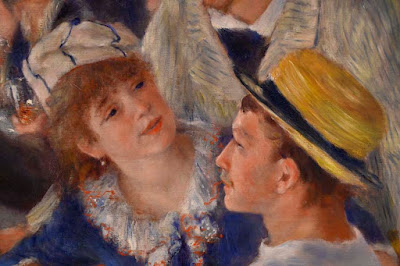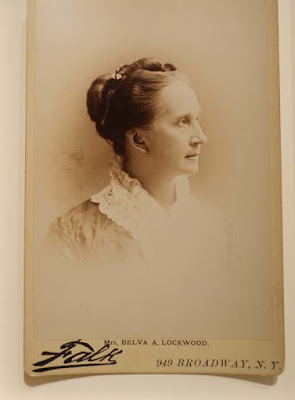 |
| Detail from Auguste Renoir's Luncheon of the Boating Party at the Phillips Collection, Washington, D.C. |
The Phillips Collection in Washington, DC. is not exactly off the beaten path, but many visitors to the capital do not realize the wealth of art that it contains. On our recent trip to Washington we discovered that the museum was just a few blocks from our hotel, so we went for a visit.
 |
| Music Room, Phillips Collection, Washington, D.C. Note the ornate gold ceiling. |
In 1921, Duncan Phillips, and his wife, Marjorie Acker Phillips, a painter, turned the family art collection into a public museum, the
Phillips Memorial Gallery, in their home near Dupont Circle in Washington, D.C. The collection soon expanded and the family moved across the street, turning over the entire house to art.
 |
| Henri Matisse, "Interior with Egyptian Curtain." The curtain is based on a Middle Eastern textile owned by the artist. |
From the beginning the collection focused on “modern” art, acquiring paintings by French Impressionists such as Monet and Renois and Cubists such as Picasso and Braque. Giving equal focus to American and European artists, Phillips juxtaposed works by Winslow Homer, Thomas Eakins, Maurice Prendergast, James Abbott McNeill Whistler, and Albert Pinkham Ryder with canvases by Pierre Bonnard, Peter Ilsted and Édouard Vuillard.
 |
| Luncheon of the Boating Party by Auguste Renoir |
But the painting that makes the museum famous and draws the most visitors is Renoir’s Luncheon of the Boating Party. On our recent visit to the Phillips Collection we happened upon a docent talk in which we learned the identities of all the people depicted in the painting and the history of its acquisition. (The man in the lower right corner is painter Gustave Caillobot, a friend and financial supporter of Renoir.) Phillips paid $125,000 for the painting–a sum far beyond anything that had ever been paid for a painting before. It turned out to be a good investment!
 |
| Early Spring by Pierre Bonnard |
As the collection expanded over the years it became necessary to add a new wing to the museum. Every room is filled with remarkable art. One small room is devoted to four paintings by Mark Rothko, each intense canvas taking up most of each wall. Standing in the middle one feels bathed in color on every side. (It is the one room in the museum where photography is not allowed.)
 |
| Migration Series by Jacob Lawrence |
Another room contains the 60 paintings of the Jacob Lawrence Immigration Series, depicting the migration of African Americans from the rural South to the urban North.. As one circles the room, it is like reading a book. In another room was a remarkable series of photographs, all taken at night and therefore very dark, but with small glimmers of light. The series traces stops on the Underground Railway as they look today.
The Phillips Collection continues to expand and in two years will be celebrating its 100th anniversary.
Visiting the permanent collection is free. Special exhibits require paid tickets. We did not have time to see those.
The museum has a nice small café (where we had lunch) and a very nice gift shop. And when I went to the ground floor to the rest room, I passed an exhibit of children’s art created in a joint project of the museum and the Maryland Department of Education. Art education is so often neglected in today’s schools, so I was pleased to see the museum’s involvement in the local community.





























